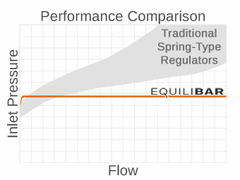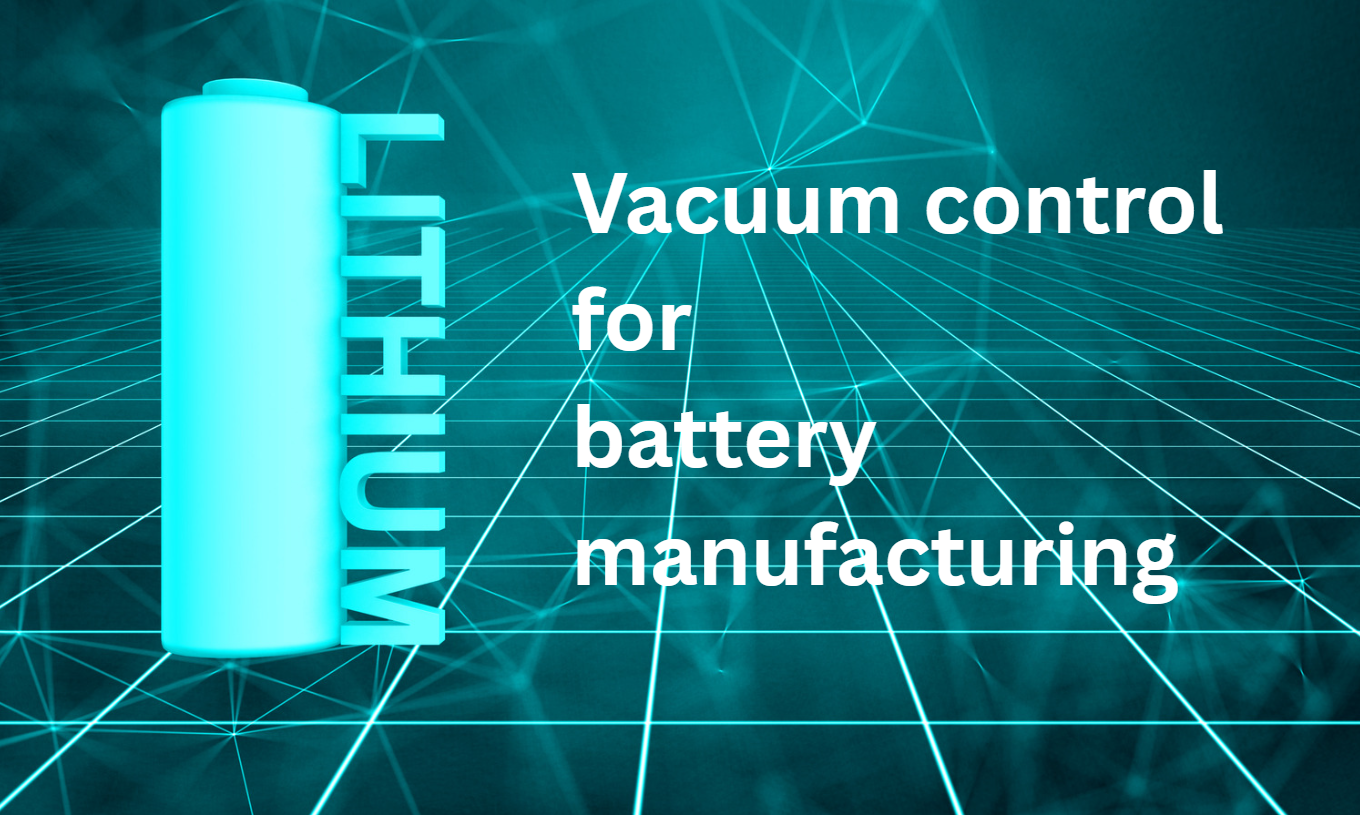What makes the Equilibar valve technology unique?
The Equilibar® back pressure regulator (BPR) has a unique design that provides more precision than ordinary back pressure regulators. It’s multiple orifice design results in precision control across an ultra-wide flow range, typically 100 times industry norms. A supple diaphragm is the only moving part, enabling frictionless operation without hysteresis or cracking pressure. Because it is dome-loaded, the Equilibar BPR provides reliably stable pressure. Equilibar fluid and pressure control products deliver reliable performance for some of the world’s most complex process conditions.
How is the setpoint established for the Equilibar regulator?
The Equilibar BPR is a dome-loaded pressure regulator with pilot operation. This means that gas or air is fed into the top (dome) area of the regulator to provide the pressure setpoint for the process. The pressure of the gas in the dome is set by a secondary standard pressure regulator called a pilot regulator. The pilot regulator can be manual or electronic, depending on the application’s requirements.
How is Equilibar technology different from other dome-loaded back pressure regulators?
The Equilibar BPR is a type of dome-loaded pressure regulator, but uses a innovative seat design giving it much higher precision and stability from 0 – 100% of its flow range. A lightweight, supple diaphragm covers and seals the parallel orifices in the Equilibar body. As fluids flow through the unit, the Equilibar holds the process pressure to equal the pilot setpoint. Traditional back pressure regulator seat designs are typically optimized to be stable in limited flow ranges. Learn more about How it Works.
Can an Equilibar BPR control low pressures?
The Equilibar BPR offers unmatched performance in very low pressure ranges, with excellent control down to about 1 in H20 / 25.4 mm H20 (0.02 psig / 1.4 mbar(g)). Depending of flow and body size, it can easily achieve precision better than 0.25 in H20 / 6.4 mm H20 (0.01 psig / 0.69 mbar(g)). Learn more about the benefits of using Equilibar BPRs for low pressure control or view our full line of low pressure solutions.
What other features make the Equilibar back pressure regulator unique?
- Springless: A special flexible diaphragm is the only moving part
- Simple, sanitary designs are available for pharmaceutical, personal care products and food industries
- Extremely fast response
- Dampens system pulsations
- Pilot pressure can be set using process fluid (fluid pressure balancing)
- Compatible with problematic viscous and shear sensitive applications
- Can be configured to provide precise flow control
How can I use the Equilibar back pressure regulator to automate my process?
The Equilibar BPR excels in computer automation applications. By connecting an electro-pneumatic transducer ( electronic pressure controller) to its reference port, the Equilibar BPR allows the process computer to vary process pressure with precision to 0.01 psig / 0.69 millibar(g). This could be used for everything from simple flow rate control to controlling reactor conditions in a research environment.
Where are back pressure regulators used?
Back pressure regulators are used where pressure needs to be controlled downstream of the process. For instance, BPRs are used at the outlet of a chemical reactor to control the reaction pressure. They are also used in pump recirculation loops where process fluids are drawn intermittently and the line pressure must remain constant. For this application, the BPR would be used at the end of the recirculation loop to maintain pressure in the entire recirculating line.
Another place BPRs are used, is in test equipment where varying pressure conditions are tested for product quality. Oftentimes these test stands have to test pressure across a wide range of flow rates, so some BPR designs are better than others.
Features and Benefits
- Easy Process Automation
- Ultra Low Pressure
- Ultra Low Flow
- Shear Sensitive Fluid Compatibility
- Suitable for Pharmaceutical, Food, and Bio-Engineering Industries
- 1:1 Pressure Equilibrium
- Ultra-Fast Action
- Pulsation Dampening
- Drip-Tight Performance
- Eliminates Overpressure
Ultra Low Pressure
The Equilibar BPR has the lowest pressure control range and highest sensitivity in its class. It can control setpoint to 0.02 psig / 1.4 millibar(g) and below, with sensitivities to 0.01 psig / .069 millibar(g)
Note: ultra high precision typically applies to gas applications or very low flow rate liquid applications due to the inherent fitting losses in all liquid controls.
Ultra Low Flow Rates
Typical spring and plunger designs have a difficult time seating properly at extremely low flow rates, especially in gas control. The Equilibar BPR, however, can be configured specifically to perform at low flow rates using the “low flow” or “zero flow” trim for applications requiring extremely low flow rates.
Easy Process Automation
Equilibar fluid control valves are easily configured for computer automation. The pilot pressure setpoint is established on the dome of the Equilibar BPR using a high definition electronic pressure regulator (electro-pneumatic transducer; E/P; I/P). A signal from the process computer is sent to the electronic pressure regulator (EPR), and feedback from a pressure transducer allows the computer to keep the EPR in control. The pressure balance between the dome of the Equilibar BPR and its inlet is maintained by the flexible diaphragm.
Shear Sensitive Fluid Compatibility
The Equilibar BPR can tackle tough shear sensitive fluids and dispersions where traditional fluid controls fail. The flexible diaphragm membrane throttles fluid pressure in a less abrupt manner than traditional valve seats. The self adjusting nature of the membrane allows the valve to easily pass particulate matter.
Suitable for BioPharma, Food, and Personal Care Industries
Equilibar FD Series and SD series back pressure regulators are designed specifically for sanitary applications in the food & beverage, biopharmaceutical, and consumer products industries. They can be constructed with Class VI certified materials for strict biopharmaceutical use. The main valve body can be disassembled easily for quick and easy inspection and cleaning. Valve seats are inherently crevice-free and can be readily flushed with Clean-In-Place (CIP) solution, steam (SIP), or water.
1:1 Pressure Equilibrium
The pressure relationship between the reference and process ports in not simply proportional, as with existing pilot-actuated control devices. The Equilibar® Pressure Regulator attempts to maintain this relationship in 1:1 equilibrium naturally – with no calibration needed or possible. (Various configurations are available that add a slight opening or closing bias to this equilibrium)
Ultra-Fast Action
Because the only moving part in the Equilibar BPR is a flexible diaphragm, there is no friction, and virtually no inertia to slow reaction times. Consequently, the action of this device is extremely fast, nimble, and responsive.
Pulsation Dampening
By using this device in the flow-through configuration, the Equilibar helps to dissipate pressure pulsations by directing much of the excess pressure wave into the exhaust port. This is particularly effective when the device is used on the outlet of a diaphragm pump, as illustrated in the Pump Pressure Control application.
Drip-Tight Performance
Conventional relief valves require significant seat loading forces to eliminate dripping. Even devices with compliant seats can drip as they approach their cracking pressure. The Equilibar BPR has the unique ability to remain drip-free to within a fraction of a psig of setpoint.
Eliminates Overpressure
Traditional relief valves open up gradually only as overpressure compresses the spring to its most retracted position. The Equilibar BPR eliminates this design complication by providing full open flow at less than 1 psig / 68.9 millibar(g) overpressure.
Contact our engineers to discuss your unique application.

Our performance curves document pressure stability across flow rate ranges as high as 10,000:1.
Contact us with questions about back pressure regulators
Contact Equilibar

